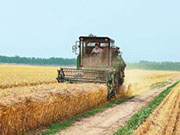China to modernize, restructure agriculture sector

 0 Comment(s)
0 Comment(s) Print
Print E-mail CNTV, March 8, 2016
E-mail CNTV, March 8, 2016
This year's No. 1 Central Document on agriculture shows supply side reforms will be applied to agricultural modernization, not just to increase the quantity and quality of agricultural products, but also meet the needs of China's modern agricultural market. Our reporter Xia Ruixue went to the country's largest grain producer, Henan Province, to see how authorities there are implementing the new policy.
58-year-old Lu Jianshan doesn't have to hand spray his crops with pesticides. For a set price, he can rent a drone to do this. And when it's time to harvest, he can also hire help and rent other machinery.
Today, with the continued migration of young people from the countryside to cities, many of China's elderly farmers are left behind to do the work themselves. More modernized machinery may be making their work easier at the moment, but it's only temporary relief.
To utilize its farmland efficiently, China is now encouraging farm cooperatives by accelerating rural land transfers, granting higher subsidies to large-scale landholders, and is helping to establish bigger and more specialized farming units.
China has made great achievements in agricultural and rural economic development, but is still facing serious structural problems: some produce is over-supplied, and more is in short supply. So President Xi Jinping reiterated the importance of enhancing structural reform of the supply side, in the No. 1 Central Document on agriculture this year.
It aims to comprehensively increase the quality of the supply of major agricultural products through high-quality farming. Key will be how well it can foster rural land transfers, provide better training for farmers, increase technological input and develop larger scale operations.
It's a long time since China had anything related to a "food shortage". However, its agricultural products still can't satisfy today's demand, and the amount and quality of arable land is declining. Structural reform is of great urgency to reverse these trends.





